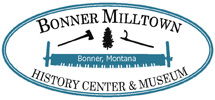End of a timber heritage
In 2008, the future for historic preservation in the Bonner area looked bleak. The mill was shuttered and equipment was to be auctioned off. Realizing that the rich history of the area would quickly fade away, long-time resident Paul Layton contacted Kim Briggeman, Missoulian newspaper reporter and local history expert, about holding informal "History Roundtables" so residents could retell past events. Kim invited local resident Judy Matson to help with the sessions. The "Bonner Area History Roundtables" were held occasionally at Bonner School with topics suggested by Kim. Recordings of the meetings were taken. Unfortunately, many were lost due to a computer crash.
Demmons photos reclaimed
Meanwhile,in an earlier visit to the school, Kim Briggeman discovered a treasure-trove in an unlikely place: the Bonner School custodian's office. Leaning against the wall in a back corner were 199 two-foot by three-foot poster boards containing approximately 1600 historic photos collected by Jack Demmons between 1976 and 1980 under sponsorship of the Hellgate Lions Club. With Superintendent Doug Ardiana's permission, Kim painstakingly cataloged each photo, saving the collection and making it searchable and useful for research for the first time. This work provided much of the historic evidence required for the historical assessment preceding the EPA's Superfund cleanup of Milltown Reservoir. Thanks to Mr. Ardiana, the collection was moved from its lowly back wall location to in a case in the Bonner School Library and given a proper name: the Jack L. Demmons' Photographs of Bonner, Montana.
The Superfund cleanup plays a role
Coincidentally, the Milltown Superfund Redevelopment Working Group was meeting, charged with planning redevelopment strategies for the restored Superfund Site at what was the Milltown Reservoir. The History and Culture Committee, Mike Kustudia and Judy Matson, chair, reached out to museum professionals for help in historic preservation efforts. Minie Smith, a Missoula author of museum displays and books on historic topics, attended these meetings and soon became actively involved in the History and Culture Committee.
One responsibility of the History and Culture Committee was to have the Demmons' Collection scanned and preserved. Under supervision of the University of Montana archivists, the project was completed, paid for by funds set aside for historic preservation in the State of Montana/ARCO Consent Decree awarded following a successful lawsuit by the State for money to mitigate damage to natural resources following the 1908 flood. The Demmons' Collection was thus added to the digital library of the University of Montana Archives and eventually to the Montana Memory Project where it is available today.
It was natural that the overlapping interests expanded to focus on formally saving Bonner area history. With Mr. Ardiana's cooperation, Kim, Judy and Minie researched and digitized the out-of-print A Grass Roots Tribute, The Story of Bonner, Montana, making this significant history of the community once again available.
The History Center finds a home
Judy and Minie met with Milltown native and longtime mill employee Jimmie Willis to discuss ways to save Bonner's history. Holding more formal Roundtables with panels of knowledgeable locals was chosen as a good strategy. Programs were to be recorded by Missoula Community Access Television for future reference.
Jimmie contacted other interested amateur historians who enthusiastically joined the committee. The first History Roundtable was held at St. Ann Catholic Church on January 25, 2009. Panel members Glenn Smith, Art Bailey, Rudi Miller, and Cal Bonnet talked about "Working at the Mill," the first program of three that year. The programs were so well received that more programs were planned for January, February, and March of following years and are still being scheduled.
The group needed a place to meet and to conduct oral history interviews. The Gateway Federal Credit Union, which operated in the Bonner Post Office building for many years, had moved to Missoula, leaving a vacant space. Building owner Scott Cooney agreed to the use of the space for a History Center and provided free rent and utilities. On a cold November day in 2009 the group first entered their new unheated space. For Jimmie, Glenn Max Smith (Hooligan), and Dennis Sain, this spot brought back fond memories of George's Cafe, the library, and the Credit Union.
Soon the utilities were connected and the space was cleaned and ready for furnishing. Anna Sain, for the grand sum of $78 dollars, bought furnishings at rummage sales, Minie Smith gleaned office supplies from Forest Service discards, and a Preserving Missoula County History grant from the Historical Museum at Fort Missoula provided funds to buy computers, a printer, and recording equipment. The Bonner Milltown History Center was a reality!
As word about the Center spread, folks began donating items rescued and saved from the mill over the years as one company succeeded another. Jimmie recognized that it was important to bring people into the Center and he began hosting Tuesday morning coffee and conversation sessions. From a couple of visitors early on, Tuesday morning has become a popular time for longtime residents and mill workers to reminisce and enjoy Jimmie's freshly baked cookies.
Anna noted the lack of a logo and after much discussion, designed a logo that is the basis for today's logo and sign. As our collection grew, the words "and Museum" were added to our name.
The Bonner houses and Post Office building were acquired by Mike Boehme and Steve Nelson, Bonner Property Development, LLC, following their purchase of the mill in 2011. Mike and Steve generously allowed us to continue using the space with rent and utilities donated.
